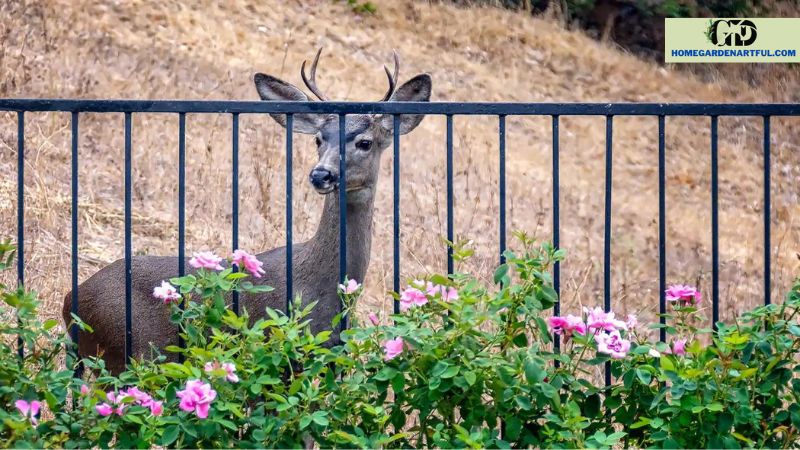Deer damaging your beloved garden can be a frustrating and disheartening experience. As gardening enthusiasts, we put our heart and soul into creating beautiful, thriving spaces, only to find them ravaged by these graceful yet destructive creatures. But fear not! In this article, homegardenartful will share with you an ingenious solution that can help protect your garden from the relentless nibbling of deer: fishing line.
Introduction
Overview of the problem: Deer damaging gardens
Picture this: you wake up one morning, eager to tend to your garden, only to find your precious plants stripped bare, their leaves reduced to a mere memory. Deer, with their voracious appetites, can wreak havoc on your carefully nurtured greens, leaving you feeling defeated. However, with the right knowledge and tools, you can successfully deter these garden invaders.
Importance of finding effective solutions
As gardeners, we understand the importance of maintaining the integrity and beauty of our outdoor sanctuaries. Deer not only compromise the aesthetics of our gardens but also disrupt the delicate balance of our ecosystems. Furthermore, the financial investment and emotional attachment we have towards our plants make it crucial to find effective measures to keep deer at bay.
Introducing the use of fishing line as a deterrent
Imagine a simple, cost-effective solution that can provide an invisible barrier between your precious plants and those pesky deer. Enter fishing line – a versatile material that can be easily employed to deter deer from entering your garden. In this article, I will guide you through the step-by-step process of installing fishing line to keep deer out and share tips for its maintenance.
Now that we understand the extent of the problem and the necessity for effective solutions, let’s dive into the world of fishing line as a powerful deterrent against deer intrusion. Stay tuned for the next section, where we will explore the behavior of deer and understand why they find our gardens irresistible.
Understanding Deer Behavior
Deer, with their graceful presence and gentle demeanor, can easily captivate our hearts. However, when it comes to our gardens, their behavior can leave us feeling exasperated. To effectively deter deer, it is essential to understand their feeding habits, preferences, and why they are drawn to our gardens in the first place.
Insights into deer feeding habits and preferences
Deer are herbivores, which means their diet primarily consists of plant material. They have a particular fondness for tender, succulent plants such as young shoots, flowers, and foliage. Understanding their preference for certain types of vegetation can help us strategically protect our most vulnerable plants.
Explanation of why deer are attracted to gardens
Why do deer find our gardens so alluring? Well, gardens often provide a veritable feast for these ruminants. Lush vegetation, nutrient-rich soil, and a diverse array of plants make our gardens an irresistible buffet for deer. Additionally, as urbanization encroaches upon their natural habitats, deer are increasingly drawn to suburban and residential areas where gardens offer an abundant and easily accessible food source.
Identifying the need for physical barriers
Now that we comprehend the feeding habits and attraction of deer to our gardens, it becomes evident that simply relying on their goodwill to stay away is not a viable option. To effectively keep deer out, physical barriers are necessary. While there are various methods available, we will focus on the use of fishing line as a practical and efficient deterrent.
Understanding deer behavior and their affinity for our gardens is the foundation for successful deer deterrence. Armed with this knowledge, we can now proceed to the next section, where we explore the benefits of using fishing line as a barrier.
Exploring the Benefits of Using Fishing Line
When it comes to keeping deer out of your garden, fishing line proves to be an exceptional solution. Let’s delve into the numerous benefits that make it a popular choice among gardeners.
Cost-effective and easily accessible material
Unlike expensive fencing or chemical repellents, fishing line offers a budget-friendly alternative that won’t break the bank. You can find fishing line at your local sporting goods store or even online, making it easily accessible for everyone. With just a small investment, you can effectively protect your garden from deer damage.
Environmentally-friendly alternative to chemical repellents
In this era of environmental consciousness, it’s essential to seek eco-friendly solutions for our garden woes. Fishing line fits the bill perfectly. By opting for fishing line over chemical repellents, you avoid introducing harmful substances into your garden ecosystem. This not only protects your plants but also helps maintain the delicate balance of the natural environment.
Versatility and adaptability in garden setups
Every garden is unique, and fishing line offers the flexibility to adapt to various garden setups. Whether you have a small, urban garden or a sprawling countryside landscape, fishing line can be easily installed to suit your specific needs. It can be used to create a simple perimeter barrier or strategically placed to protect specific plants or areas within your garden. The versatility of fishing line ensures that you can tailor its usage to effectively deter deer.
By utilizing fishing line, you not only save money but also contribute to the preservation of our environment. Its adaptability makes it a versatile tool in safeguarding your garden from the persistent grazing of deer. In the next section, we will delve into the step-by-step process of installing fishing line to create an effective barrier. Stay tuned to learn how to keep your garden deer-free!
Step-by-Step Guide: How to Install Fishing Line to Keep Deer Out
Keeping deer out of your garden requires a well-executed plan, and installing fishing line as a deterrent is no exception. Let’s walk through a step-by-step guide to ensure you set up your fishing line barrier effectively.
Assessing the garden perimeter for the best placement
Before you begin, take a stroll around your garden and carefully observe the areas where deer are most likely to enter. Look for signs of their presence, such as trampled foliage or droppings. These will serve as valuable indicators for determining the ideal spots to install your fishing line. Focus on areas where deer can easily access your garden, such as gaps in fencing or natural entry points.
Choosing the appropriate height and tension for the fishing line
The height of your fishing line is crucial to deter deer effectively. Optimal placement is typically around 3 to 4 feet above the ground, as this aligns with the average shoulder height of deer. Adjust the height accordingly based on the deer species in your area. To maintain tension, use sturdy supports like wooden posts or existing structures, ensuring the line remains taut and unyielding.
Properly securing the line to ensure effectiveness
To keep your fishing line barrier intact, secure it tightly between the supporting posts or structures. Utilize durable knots, such as the improved clinch knot or the Palomar knot, to prevent the line from loosening or breaking. Regularly inspect the tension and condition of the line, making adjustments as necessary to maintain its effectiveness.
Additional tips for maximizing the deterrent effect
Enhance the effectiveness of your fishing line barrier by incorporating additional deterrent measures. Consider applying deer repellents or creating noise and motion distractions near the fishing line to startle and discourage deer from approaching. Additionally, periodically move and adjust the fishing line to prevent deer from becoming accustomed to its presence.
By following these step-by-step instructions, you can successfully install a fishing line barrier to keep deer out of your garden. In the next section, we will explore how to maintain and adapt the fishing line to ensure its long-term effectiveness.

Maintaining and Adapting the Fishing Line Barrier
Once you have successfully installed the fishing line barrier, your job is not done. It is crucial to regularly maintain and adapt the barrier to ensure its effectiveness in deterring deer from your garden. Here are some important steps to follow:
Regularly inspecting and adjusting the line as needed
Just like any other garden maintenance task, regularly inspecting your fishing line barrier is essential. Over time, the line may sag or become loose, compromising its effectiveness. Take a stroll around your garden and check for any signs of drooping or damage. If you notice any issues, promptly tighten or replace the line to maintain its tautness and integrity.
Addressing potential challenges or issues
While the fishing line barrier is a highly effective deterrent, there may be instances where deer find ways to breach it. Pay attention to any areas where deer may attempt to enter, such as low-hanging branches or gaps in the line. By identifying these weak points, you can take appropriate measures to reinforce the barrier, such as adding additional lines or adjusting the height.
Supplementing the barrier with other deterrent methods if necessary
In some cases, particularly if you live in an area with a high deer population, it may be necessary to supplement the fishing line barrier with other deterrent methods. Consider using deer repellents, motion-activated sprinklers, or even planting deer-resistant plants alongside the fishing line. These additional measures can provide an extra layer of protection for your garden and help ensure its long-term defense against deer.
By regularly maintaining and adapting your fishing line barrier, you can effectively deter deer from your garden and protect your cherished plants. Remember to inspect, adjust, and supplement as needed to stay one step ahead of these persistent creatures. In the next section, we will conclude our journey and recap the benefits and effectiveness of using fishing line as a deer deterrent.
Conclusion
Throughout this article, we have explored the ins and outs of using fishing line as a practical and effective method to keep deer out of your beloved garden. By utilizing this simple yet ingenious solution, you can protect your plants, maintain the beauty of your outdoor space, and coexist harmoniously with wildlife.
In conclusion, the benefits of using fishing line as a deterrent are undeniable. Not only is it cost-effective and easily accessible, but it also offers an environmentally friendly alternative to chemical repellents. Its versatility and adaptability make it suitable for various garden setups, ensuring that you can safeguard your plants regardless of their size or layout.
Remember, the key to successfully keeping deer out of your garden lies in proper installation and maintenance of the fishing line barrier. Regular inspections and adjustments are necessary to ensure its effectiveness. Additionally, if you encounter any challenges, don’t hesitate to supplement the barrier with other deterrent methods to enhance protection.
Now, armed with the knowledge and understanding of deer behavior, you can confidently take action to safeguard your garden. Embrace the power of fishing line and bid farewell to the frustration of deer-damaged plants. By implementing this simple yet effective solution, you can enjoy the beauty and serenity of your garden without sacrificing its well-being.
So, what are you waiting for? It’s time to take a stand against garden-invading deer and protect your floral haven. Install that fishing line, maintain it diligently, and revel in the satisfaction of a thriving, deer-free garden. Happy gardening!
Remember, nature is unpredictable, and it’s always a good idea to consult with local wildlife authorities or experts to ensure you are acting in accordance with the laws and regulations in your area.


